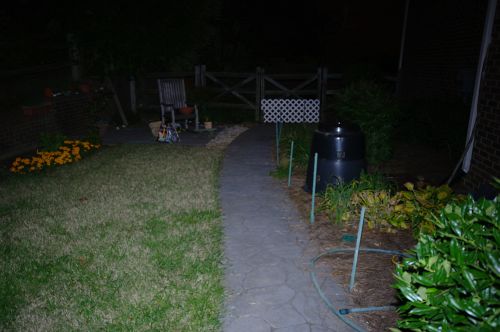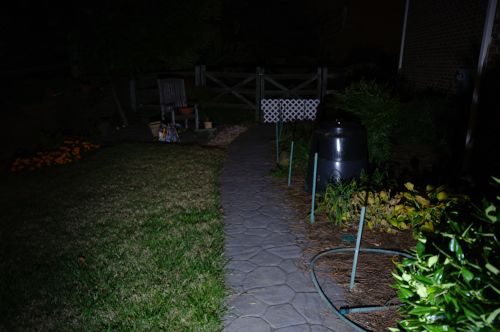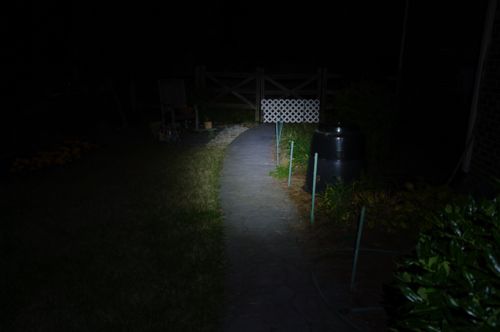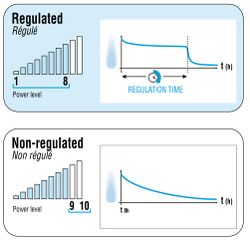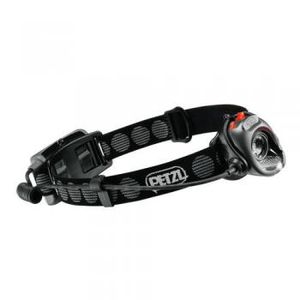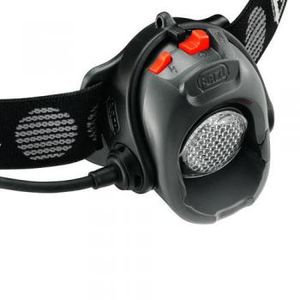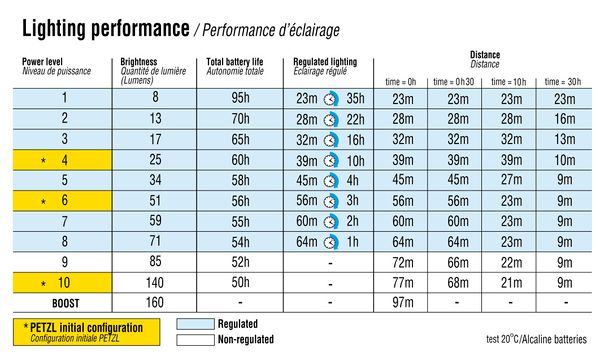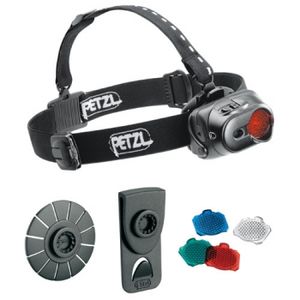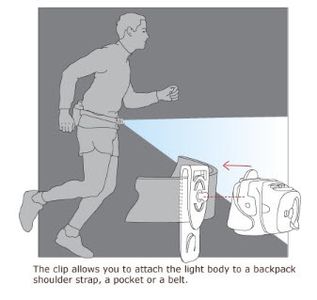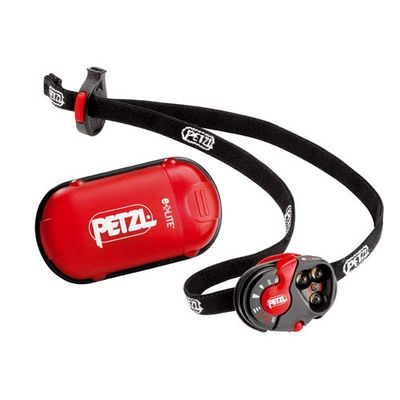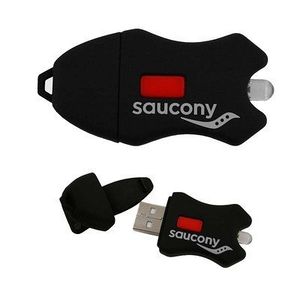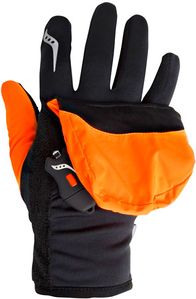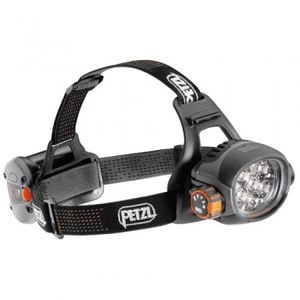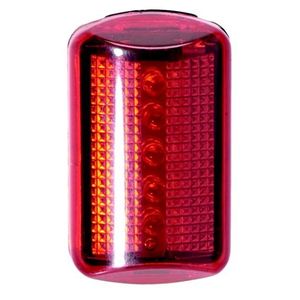Best Running Lights

| Light | Why it's recommended | Cost |
|---|---|---|
| Petzl MYO RXP | The best head light available for a reasonable cost | $90 |
| Petzl Tactikka XP Adapt | The best head light that can be waist mounted (great for dark trails) | $70 |
| Petzl Tactikka XP | This is the same as the Petzl Tactikka XP Adapt, but without the option for waist mounting. | $60 |
| Petzl Nao | Automatic lighting level adjustment | $175 |
| Petzl e+Lite | This is a great backup/emergency light | $30 |
| Saucony USB Clip Light or Saucony Ulti-Mitt with Light | Useful as a cheap emergency light. | $10 or $45 with the Ulti-Mitt gloves |
| Petzl Ultra | Great light, but ultra expensive! | $350 |
| Petzl Ultra Belt | The Petzl Ultra with the battery mounted on your waist. Useful for extreme cold. | $500 |
There are many other LED head lights available, and most of them do a reasonable job. However, I would not use one of these cheaper lights having used the Petzl MYO RXP and Petzl Tactikka XP Adapt.
1 Types of light
There are four factors to consider with a running light; location, the beam pattern, regulation and brightness.
1.1 Location
The three locations for a light while running are handheld, waist mounted and head mounted. I do not recommend handheld lights for several reasons. The biggest problem is that keeping the light pointed in the right direction changes your arm movement and messes up your Running Form. In addition, handheld lights occupy one of your hands making it tricky to do anything in the dark, though knuckle lights overcome this. There are advantages and disadvantages to waist mounted and head mounted. Because a head mounted light is aligned with your eyes, it's hard to see the shape of the ground. This is best seen in the images below.
Other considerations:
- Head mounted directs the light where you point your head, making it easier to see where you're going. Head mounted also works better for directing the light to things in your hands, like putting on gloves or looking at your Watch.
- Waist mounted lights are much better in the rain or dusty conditions. With a head mounted light, the beam picks up the rain or dust in front of your face, making it hard to see.
- Head mounted lights are better at showing up branches or spider webs that are about to hit your face.
1.2 Beam Pattern
Most lights project a narrow spot beam, which illuminates a longer distance. Many of the Petzl lights have a diffuser than can be moved in front of the light to provide an even illumination, though it does not reach so far.
- Head or waist mounted lights
1.3 Regulation
With a regulated light the light intensity will stay constant over most of the life of the battery, and it will then grow rapidly dim. This can be seen graphically below. The regulation is nice, but when the end of the regulation period is reached, the light intensity can drop very quickly, so you need to have spare batteries with you if you expect to run out of power.
1.4 Brightness
The brightness you need depends on your situation. In many cases you just need to see what's immediately ahead of you, so brightness is not critical. If you're on trails, then a really bright light can help see what direction a trail is taking, or help with navigation. Many times I've found that having a dim light can work best, as it helps me see what's ahead without compromising my night vision, allowing me overall better visibility. A very bright light will create a pool of light that can become mentally confining and isolating. Having a light that will go both very bright and very dim is ideal, and the Petzl MYO RXP stands out for this.
2 Recommended Lights
I have tried over a dozen different lights, from the bad old days of incandescent lights that give a patchy yellow glow to new regulated LED lights. My two favorite lights are both Petzl as they have an effective diffuser. I've also tried lights from other manufacturers, but I've consistently found Petzl lights to be better.
2.1 Highly Recommended - Petzl MYO RXP
The Petzl MYO RXP is a regulated light, as described above. The light will flash a few times when the battery drops too low, which gives you some warning before it runs out of power. The RXP also support brighter output that is unregulated, which is useful when you need a lot of light for a short period of time. The regulated output can be used so that you will have power for an overnight run, and on its lowest power setting it will run for 96 hours. The RXP is also nice because it can output a very dim light. I've found this works well near dawn, where the light from the RXP on its lowest output and with the diffuser is enough to see by, but allows my eyes to adjust so that I can see a little further using the available light. I've found the RXP works well in heavy rain as long as it is in the normal position. If you run with it wrapped around your hand, the rain can get in the underside and cause problems until it dries out. The RXP uses AA batteries, so it is a little heavy, but having the batteries on the back balances things quite well. It also allows the batteries to stay warmer in cold conditions if you wear it with the back under a hat; you'll probably need two hats to make that work.
- Petzl MYO RXP
2.1.1 MYO RXP Battery Life
The battery life chart shown below can be a little confusing. The blue area shows the settings when the light is regulated, which keeps the lighting level constant until the battery level drop too low and then the brightness plummets. Here are some examples from the chart to help explain things.
- On setting #1, the light will give out a steady (regulated) 8 lumens for 35 hour. The total battery life is 95 hours, but from 35 hours to 95 hours it will be very dim.
- On setting #8, the light will give out a steady (regulated) 71 lumens, but only for one hour. The total battery life is 54 hours, but after the first hour the light will grow rapidly dimmer.
- On setting #10, the light will start giving out 140 lumens, but it will immediately start to grow gradually dimmer. This drop in light level will be gradual enough that it will not be immediately detectable.
- The actual battery life will depend on the batteries used and the temperature. The chart is for fresh alkaline batteries at 68f/20c, and cold weather can reduce the battery life quite a bit. Lithium batteries will last longer and rechargeable batteries will last for less time.
- The claimed battery life matches up with my experiences. I use the Enloop Low Self Discharge rechargeable batteries, so I get slightly less runtime than indicated, but it's close.
2.2 Highly Recommended - Petzl Tactikka XP Adapt
The Petzl Tactikka XP Adapt is not as bright as the Petzl MYO RXP, but it can be waist mounted. This works best with compression shorts/tights to prevent the light wobbling around. I've found this works far better on trails than a head mounted light. The XP Adapt uses AAA batteries, so it's lighter than the Petzl MYO RXP. If you don't need the waist mounting, then the Petzl Tactikka XP is the same light without the adapter kit, and it's quite a bit cheaper than the MYO RXP.
- Petzl MYO RXP
2.3 Petzl Nao
The Petzl Nao is a sophisticated light that automatically adjusts the brightness. There are two bulbs, one with a diffuse wide beam and the other with a narrow focused beam, along with a light sensor. When the light is pointing slightly down, the wide beam is used, and when you look up, the focused beam comes on as well. When you look at something close up, the wide beam comes on at a dimmer level. This works quite nicely when running, as it uses the wide beam when you're looking near your feet, and a longer throw when you look up to see further ahead. If you look at your watch (or anything else close up) it uses a dimmer light. You can also program the light using a computer (PC or Mac) to set the intensity of the three beams (wide beam, narrow beam and wide beam close up). However, the close up mode is also activated if a light is shining at you, making it a poor choice for running near oncoming cars. You can change to a constant mode, but that defeats the purpose of the light somewhat. The Nao comes with a rechargeable battery, but can also take 2 AAA batteries and you can buy spare batteries for about $60. The battery life varies on usage, so if you're doing a longer run, you'd want to carry spare batteries. The rechargeable batteries probably make this unsuitable for many overnight ultras. The headband is different to other Petzl headlights, and it works okay. It's easier to adjust, but I didn't find it as comfortable as the RXP. There is a$30 optional kit to put the battery on your belt, which is great for extreme cold conditions. Overall the Nao is a nice light, and worth considering if your style of running would benefit from the adaptive lighting.
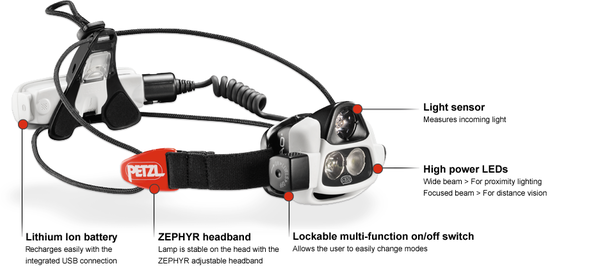
2.4 Petzl e+Lite
The Petzl e+Lite worth considering as a backup light, but don't use this as your primary light unless weight is of paramount importance. It's not bright enough and the lithium batteries are pricy. However, it will fit in the pocket of my shorts, so it makes a great 'oops' light.
2.5 Saucony USB Clip Light
This light is tiny, but will provide enough light in an emergency. It's so small it's easy to clip to clothing, and you can get the light included with other Saucony gear. I have the Saucony Ulti-Mitt which comes with the light and has a place for it to clip on that works well. (These are one of my favorite gloves, with the convertible cover to turn them into mittens.) One caveat is that the light does not hold its charge well, so leave it plugged in.
- Saucony USB Clip Light
2.6 Petzl Ultra
I don't believe the Petzl Ultra offers good value for money, but it may be worth considering if you need the very best in head lighting. This light is also available as the Petzl Ultra Belt with the battery on a long cord so it can be waist mounted. This is a good idea if you need a light for use in extreme cold, as low temperatures sap the battery power. (Petzl used to make the MYO XP Belt, but it's been discontinued.)
- Petzl Ultra
2.7 Safety Light
A flashing red light clipped to the back of your waist band is a worthwhile addition for running in urban situations. The Nathan Clip-On Safety Strobe is less than $10.
3 Batteries
I use Enloop Low Self Discharge rechargeable batteries in my lights. The 'low self discharge' means that they won't go flat if you leave them in a drawer for a few weeks. I got the La Crosse Technology BC-700 Alpha Power Battery Charger which is more expensive than many at $50, but well worth it for keeping the batteries healthy.
